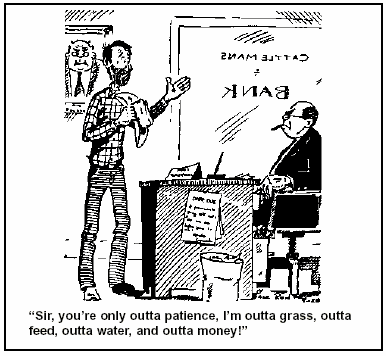



Managing Residual Forage for Rangeland Health
By C. Wayne Hanselka, Larry D. White and Jerry L. Holechek, Professors and Extension Range Specialists, The Texas A&M University System; and Professor of Animal Science, New Mexico State University.In its most practical sense, livestock grazing is a tool used to manage the financial, climatic and ecological risks associated with the rangeland livestock enterprise. The goal of grazing management should be to maintain and enhance the health of the rangeland.
Healthy rangeland is land on which all ecological processes can be sustained indefinitely. Sustainability for long periods can be expected as long as the conditions of the soil, soil moisture and vegetation remain within a certain range.
Ecological and Management Thresholds
There are a number of ecological thresholds on rangelands. An ecological threshold is a point at which an irreversible change in the health and sustainability of rangeland may occur. Examples of ecological thresholds are changes from healthy grassland to grassland invaded by other plants, and from natural erosion to accelerated erosion.Management thresholds are points at which management must be changed to avoid crossing an ecological threshold. The wise manager does not wait until the health of the land is at risk to make changes, but manages conservatively, with a sizeable margin for error
Implications of Overuse
Range health is more directly related to the amount of forage ungrazed than the amount consumed. So, a critical measure of rangeland health is the amount of residual forage left after grazing. When land is overgrazed, the number of desirable plants decreases while the number of undesirable plants increases. When land is grazed properly, there is a “metabolic reserve” of leaf and stem left so that the plants recover (Fig. 1). This residual forage protects the plant crown from cold, heat and insect damage.
 |
|
Figure 1. Grasses can be grazed without damage if a “metabolic reserve” is left intact and the residual forage threshold is not consistently exceeded
|
- adds organic matter to the soil, which in time improves soil structure;
- holds water so that it can infiltrate into the soil;
- reduces evaporation;
- keeps the soil cooler; and
- reduces erosion.
 |
|
Figure 2. The amount of forage left ungrazed (residue threshold) determines next year’s forage production. The most important thing is not how much rain you get, but how effective the soil moisture is for future plant growth. (No rainfall data were available for one location).
|
Measuring Forage Use
Forage use (the amount of forage removed) and residual vegetation (the amount of forage remaining) are measures of grazing intensity. The amount of forage used is a common part of most stocking rate calculations. However, annual stocking rates are usually planned before forage production occurs. Because of variations in precipitation, site productivity, seasonal growth rates, and other factors, no one can predict total annual production. Consequently, forage use cannot be accurately measured until the end of the growing season, and then only if annual production can be measured accurately. Residual vegetation (stubble height, litter, etc.) during and after grazing is much easier to gauge and better reflects grazing severity because it also indicates how well wildlife habitat, watershed health, the forage resource, and esthetic values are being maintained.In recent years threshold residue levels been quantified. Table 1 shows the minimum amounts of ungrazed forage necessary on different types of rangeland to keep plants healthy, capture rainfall effectively, and protect the soil. The levels vary according to vegetation density, growth form, annual or perennial life cycle, and other vegetative characteristics. To improve the rangeland or reduce risk, the higher amounts should be left ungrazed.

Recommendations and Suggestions
Balance stocking rates with the available forage supply to provide enough for livestock consumption, allow for the amount that will be destroyed (by insects, decay, etc.), and leave enough residue to promote the next season’s growth. The minimum amount of forage needed to meet all these requirements can be estimated. Then determine the number of head to stock or the amount of time to graze each pasture. Monitor grazing and make adjustments based on the status of residual forage.Because grazing animals selectively graze the forage plants they prefer, pay particular attention to the residues of the two to three key forage species in key areas. These species are abundant, palatable and provide the bulk of forage in a pasture. Key areas are parts of a pasture or range that can serve as indicators for the entire management unit. In general, when forage residues of key species in key areas reach the thresholds, livestock should be moved from the pasture until plants regrow.
Making timely decisions, before forage quantity or quality becomes a limiting factor, allows the manager to reduce or increase herd size gradually, while maintaining the body condition of livestock and reducing risk.
December 2001


